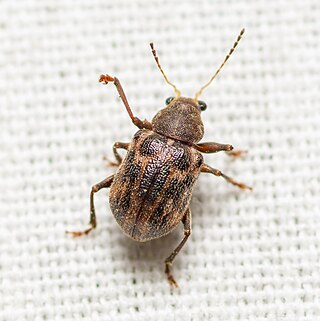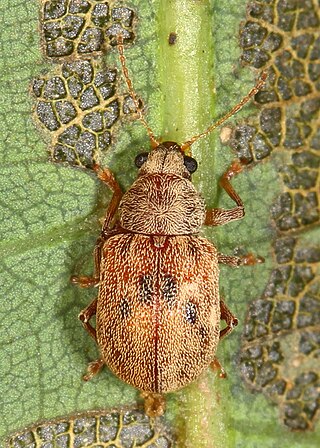
Xanthonia is a genus of leaf beetles in the subfamily Eumolpinae. It is distributed in North and Central America, and in East, Southeast and South Asia.

The Spilopyrinae are a small subfamily of the leaf beetles, or Chrysomelidae. They occur in Australia, New Guinea, New Caledonia and Chile. They were formerly considered a tribe of the subfamily Eumolpinae. The group was elevated to subfamily rank by C. A. M. Reid in 2000. However, some authors have criticised this placement, preferring to retain them within the Eumolpinae.
Neofidia longipes is a species of leaf beetle that is found in North America. It occurs mostly east of the Appalachian Mountains. It is associated with plants such as Ilex opaca (Aquifoliaceae), soybeans (Fabaceae), Salix (Salicaceae), and various Vitaceae including Ampelopsis arborea, Parthenocissus quinquefolia, and various species in the genus Vitis.

Neofidia is a genus of leaf beetles in the subfamily Eumolpinae. It is distributed in North and Central America. There are 24 species recognised in Neofidia.
Myochrous is a genus of leaf beetles in the subfamily Eumolpinae. It is known from North, Central and South America. There are over 50 described species in Myochrous. The generic name is a combination of the Ancient Greek words μῦς (mouse) and χρῶμα (color).
Neofidia clematis is a species of leaf beetle. It is known from southernmost Texas to central Veracruz, Mexico, east of the Sierra Madre Oriental. It was first described by the American entomologist Charles Frederic August Schaeffer in 1904. Two series of this species from Texas were collected from Cissus incisa, a species in the grape family (Vitaceae).

Eumolpini is a tribe of leaf beetles in the subfamily Eumolpinae. It is the largest tribe in the subfamily, with approximately 170 genera found worldwide. Members of the tribe almost always have a longitudinal median groove on the pygidium, which possibly helps to keep the elytra locked at rest. They also generally have a subglabrous body, as well as appendiculate pretarsal claws.
Anisostena is a genus of tortoise beetles and hispines in the family Chrysomelidae. There are at least 30 described species in Anisostena.

Glyptoscelis is a genus of leaf beetles in the subfamily Eumolpinae. There are 38 species of Glyptoscelis described from North, Central and South America. There are also three species of Glyptoscelis known from the West Indies, though they are wrongly placed in the genus. In addition, a single species was described from Hunan, China in 2021.
Xanthonia furcata is a species of leaf beetle. It is found in North America. It is associated with wild cherry and oaks. The specific name comes from the Latin furca, meaning "fork".
Xanthonia dentata is a species of leaf beetle. Its range spans Arizona, Colorado, New Mexico and Texas, and possibly Kansas. It is associated with oaks.

Demotina is a genus of leaf beetles in the subfamily Eumolpinae. There are over 50 described species in Demotina. The genus is native to Asia, Australia and Oceania, though one species is an adventive species in the southeastern United States in North America. Some species are known to be parthenogenetic.
Neofidia humeralis is a species of leaf beetle. It ranges from southeastern Arizona and southwestern New Mexico, along the Sierra Madre Occidental and Sierra Madre del Sur, south to Oaxaca in southwestern Mexico. It was first described as two species, Fidia humeralis and Fidia plagiata, by the French entomologist Édouard Lefèvre in 1877. These two species were later found to be synonymous.
Xanthonia angulata is a species of leaf beetle. It is found in North America. It is associated with oaks. The specific name comes from the Latin angulatus, meaning "with angles".
Xanthonia decemnotata, the ten-spotted leaf beetle, is a species of leaf beetle. It is found in eastern North America.

Neofidia lurida, the grape rootworm, is a species of leaf beetle. Grape rootworms are found in eastern North America, south to Mexico, and have been recently reported as far north as Quebec. Adults are typically 4.9 to 7.0 mm in length. They are colored mahogany brown, and are covered with white to straw-yellow hairs.

Fidia is a genus of leaf beetles in the subfamily Eumolpinae. It is distributed in East Asia, Southeast Asia and Africa.

Bromiini is a tribe of leaf beetles in the subfamily Eumolpinae. The tribe contains approximately 120 genera, which are found worldwide. They are generally thought to be an artificial group, often with a subcylindrical prothorax without lateral ridges and covered with setae or scales.

Fidia atra is a species of leaf beetle in the family Chrysomelidae. It is distributed in Japan, China, Korea, and the Russian Far East.







